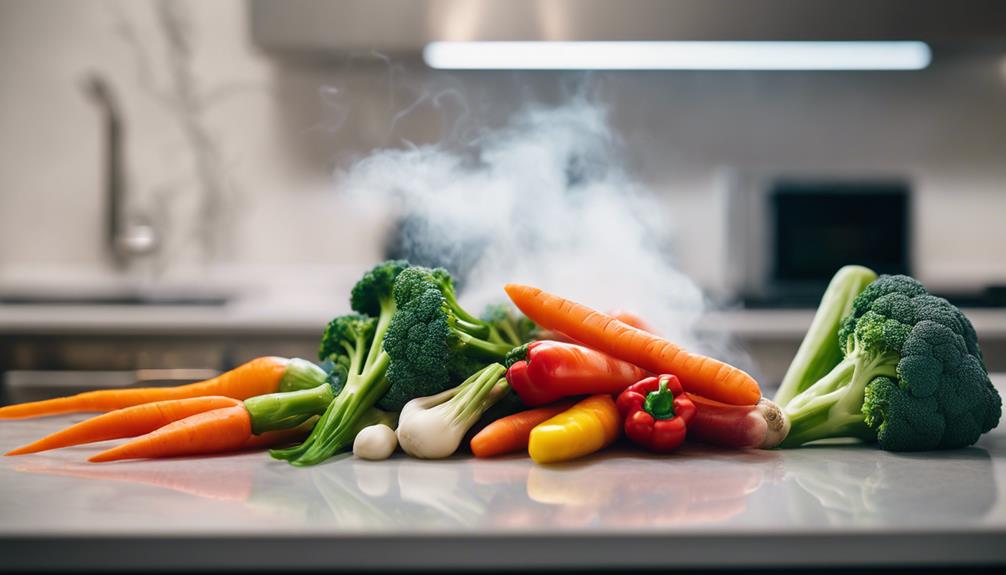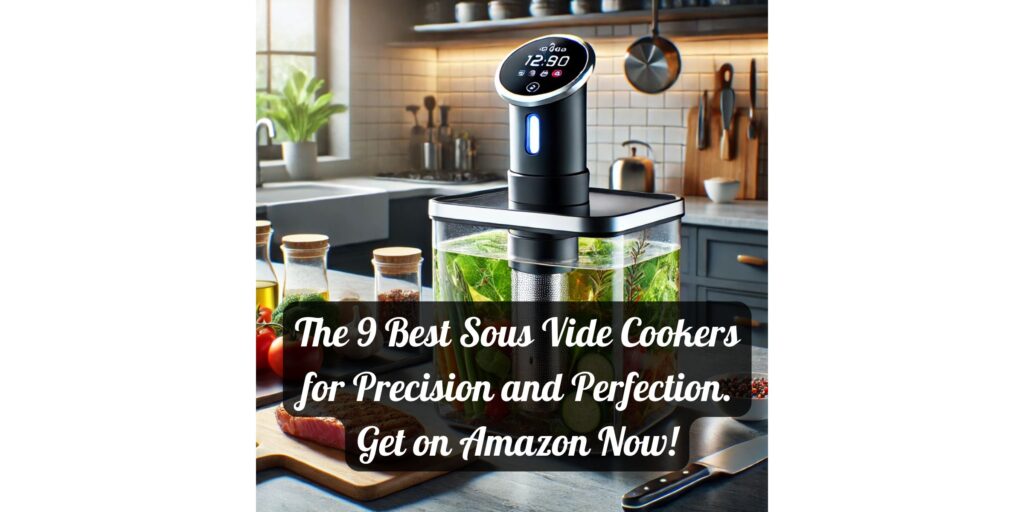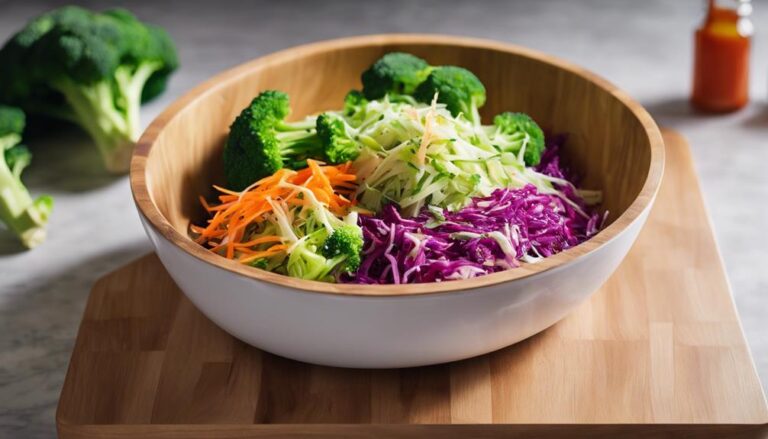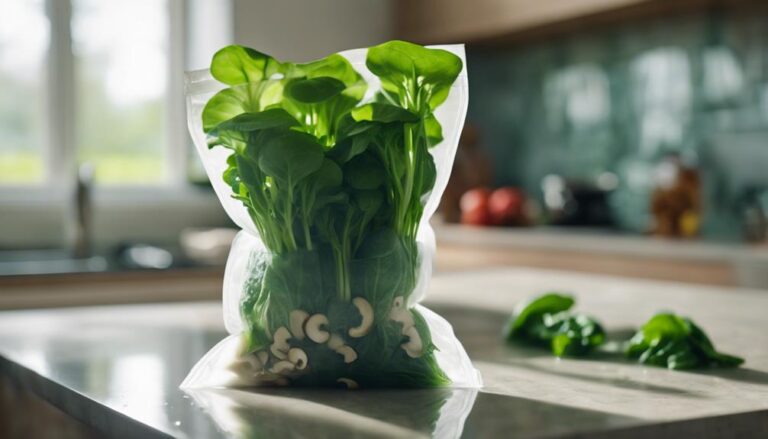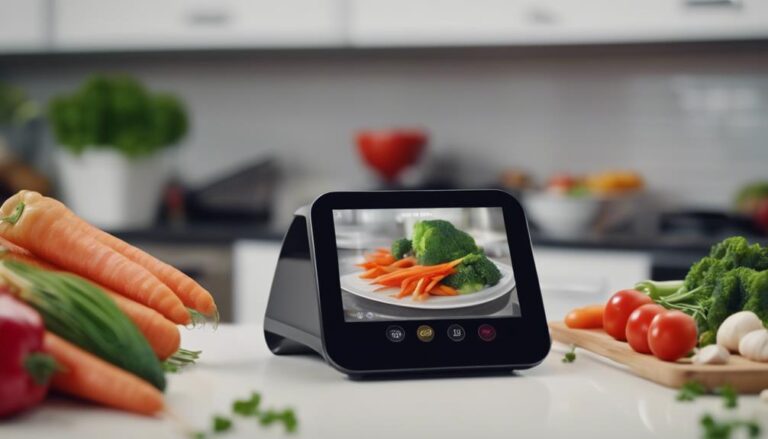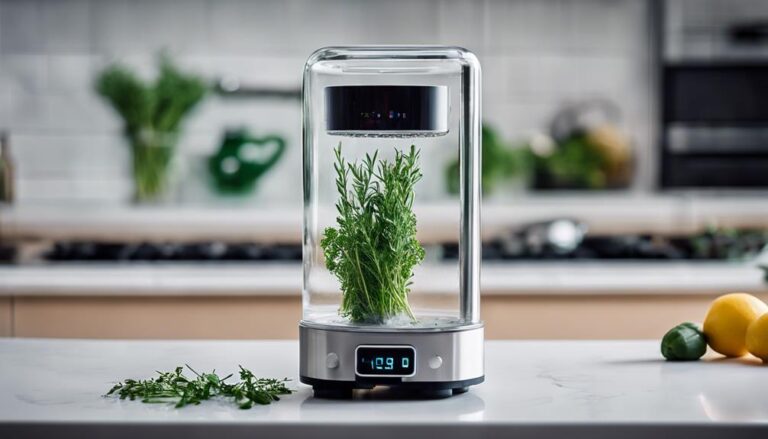Zero-Point Sous Vide Vegetable Medley
When you prepare a Zero-Point Sous Vide Vegetable Medley, you'll notice how sous vide cooking perfectly retains the fresh, vibrant colors and natural sweetness of your veggies. By vacuum-sealing each type—like asparagus at 183°F for crisp tenderness, squash at 185°F to preserve its delicate sweetness, and potatoes at 190°F for velvety softness—you guarantee that each vegetable absorbs seasonings thoroughly while maintaining nutritional integrity. The gentle, even heat enhances their distinct flavors without losing texture. It's a technique that not only preserves but elevates. Exploring further might reveal how carefully chosen flavor pairings can transform this medley into a gourmet experience.
What You Will Learn Here
- Zero-Point Sous Vide Vegetable Medley focuses on using precise temperatures to enhance natural flavors and textures.
- The medley preserves the integrity and nutritional value of the vegetables through vacuum-sealed cooking.
- Ideal cooking temperatures for the medley include asparagus at 183°F, squash at 183°F, and potatoes at 194°F.
- Cooking times vary, with asparagus and squash around 20-40 minutes and potatoes for 1-2 hours, ensuring optimal texture.
- The technique prevents overcooking, maintaining vegetable color, sweetness, and creaminess, while locking in vitamins and minerals.
Origins of Sous Vide Cooking
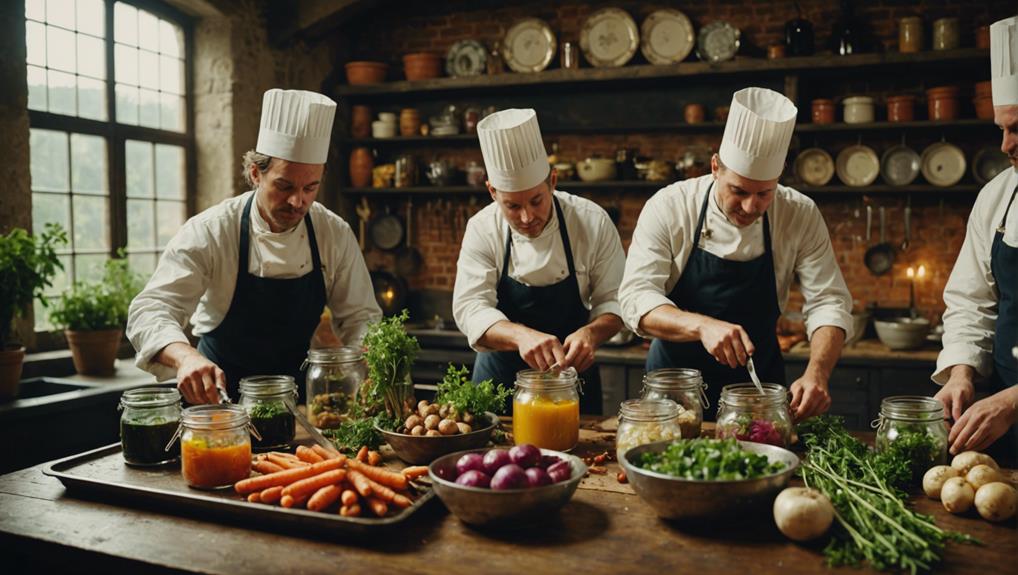
You might be intrigued to learn that sous vide, a term literally meaning 'under vacuum,' first emerged in France during the 1970s, primarily to preserve the delicate textures and flavors of fine foods.
This technique, which began in elite kitchens, leverages precise temperature control to lock in a dish's natural tastes and nutrients.
Over the decades, technological advancements have made this gourmet method accessible to you in your own kitchen, allowing you to achieve consistent, high-quality results with vegetables and more.
Historical Sous Vide Beginnings
Delving into the origins of Sous Vide cooking, it's clear that this culinary technique, which translates to 'under vacuum' in French, was pioneered in the 1970s by innovative chefs like Georges Pralus and Bruno Goussault in France. They found that using a vacuum sealer to package ingredients, such as foie gras, not only preserved flavors but enhanced textures. This method allowed them to prepare dishes like mashed potatoes ahead of time, maintaining impeccable consistency and quality.
| Year | Innovation |
|---|---|
| 1970s | Introduction of Sous Vide by Pralus and Goussault |
| Focus on foie gras integrity | |
| Introduction of vacuum sealer usage | |
| Application in professional kitchens | |
| Enhanced texture and flavor retention |
This technique revolutionized how chefs approached meal prep and consistency in flavor.
Key Technological Advances
Sous-vide cooking's leap from niche gourmet technique to mainstream kitchen staple owes much to breakthroughs in immersion circulator technology, which enabled chefs to control cooking temperatures with unprecedented precision. As the timer goes, these circulators maintain an exact heat, guaranteeing that vegetables like carrots and zucchini retain their vibrant colors and nutrients, cooked to perfection without overdoing it.
Coupled with advancements in vacuum seal technology, flavors are locked in, and food quality is preserved. This vacuum seal not only prevents flavor loss but also ensures even cooking by eliminating air pockets that could lead to uneven temperatures. You're now equipped to serve dishes that are consistently delicious, highlighting the natural tastes and textures of your ingredients, all thanks to these technological innovations.
Modern Culinary Adoption
Originating in the 1970s in France, chefs first used sous vide cooking to precisely prepare foie gras, capturing its rich flavors and delicate texture. This technique, centered around cooking precision, allows you to maintain consistent culinary results, enhancing your ability to serve dishes that are both visually appealing and gastronomically satisfying.
The culinary benefits of sous vide are significant; it preserves the natural essence and boosts the flavor profiles of even the simplest ingredients. By controlling the exact temperature, sous vide guarantees foods aren't overcooked or undercooked, thereby maximizing their nutritional content—an invaluable advantage when preparing meals that cater to health-conscious guests.
Embrace this method to elevate your cooking style, ensuring every meal you serve is a confirmation of your culinary skill and attentiveness.
Essential Sous Vide Vegetables
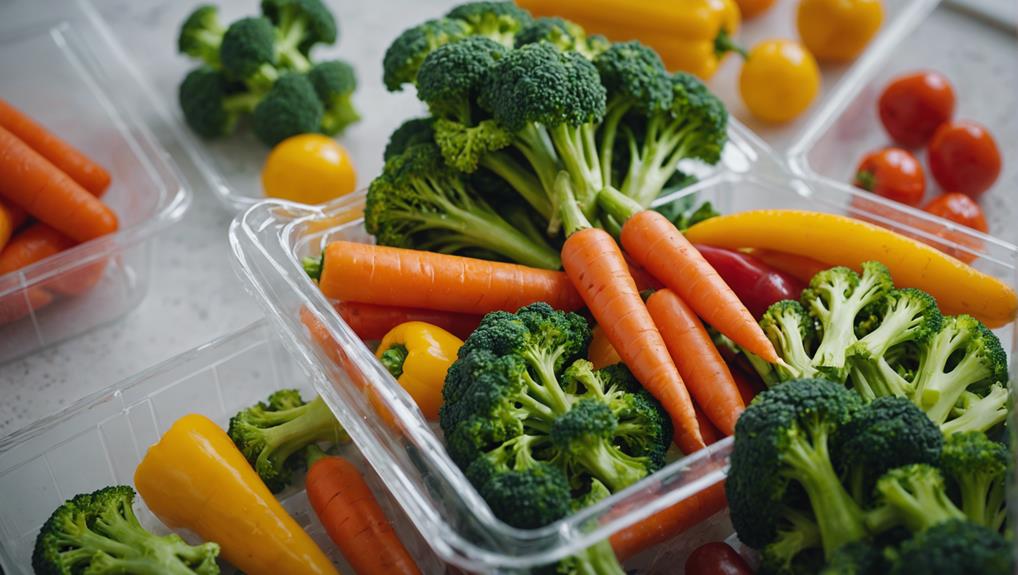
To craft a stellar zero-point Sous Vide Vegetable Medley, start by selecting essential vegetables like asparagus, potatoes, and squash, each bringing their unique textures and flavors to the dish. These vegetables not only diversify your plate but also guarantee that each bite is both delightful and nutritious.
When preparing your vegetables for sous vide, consider these steps to maximize flavor and health benefits:
- Vegetable Preparation: Trim the asparagus, peel and dice the potatoes, and cut the squash into uniform pieces. This ensures even cooking and ideal flavor absorption.
- Seasoning and Sealing: Season each type of vegetable according to your taste preferences before vacuum-sealing them in separate bags. This individual packing prevents flavor cross-contamination and aids in achieving the perfect texture for each vegetable.
- Temperature Control: Set your Sous-vide machine to the precise temperatures recommended for each vegetable. Asparagus thrives at 185°F (85°C), potatoes excel at 194°F (90°C), and squash is best at 185°F (85°C). Such accuracy prevents overcooking and helps in retaining the vibrant colors and natural crunch.
- Cooking Time: Timing is essential. Asparagus and squash might need about 30 minutes, while potatoes, due to their density, require closer to 40 minutes. These times ensure that every vegetable reaches its culinary potential, maximizing nutrient retention and flavor infusion.
Top Zero-Point Veggie Dishes
You'll find that the Sous Vide Spicy Carrot Delight not only bursts with a vibrant, sweet heat but also integrates beautifully with your calorie-conscious goals.
The Sous Vide Garlic Zucchini Ribbons offer a tender, aromatic experience, enhancing the dish's complexity without adding SmartPoints.
To cap it off, the Sous Vide Sweet Pepper Mix rounds out the flavors, providing a crisp, colorful contrast that's both satisfying and guilt-free.
Sous Vide Spicy Carrot Delight
Immerse yourself in the rich flavors of Sous Vide Spicy Carrot Delight, where the sous-vide method brings out the carrots' natural sweetness and amplifies it with a robust blend of cumin, paprika, and chili powder. This cooking technique not only enhances the flavor but also guarantees maximum nutrient retention, making every bite both delightful and beneficial for your health.
Here's why you'll love this dish:
- Flavorful Seasoning: The combination of spices infuses the carrots with a deep, complex flavor.
- Perfect Texture: Achieve tender, perfectly cooked carrots every time.
- Health Benefits: Enjoy a dish rich in vitamins with fewer nutrient losses.
- Versatile Serving: Serve as a sophisticated side or a vibrant, healthful snack.
Sous Vide Garlic Zucchini Ribbons
Explore the delicate flavors of Sous Vide Garlic Zucchini Ribbons, where precision cooking elevates this simple vegetable to an exquisite, nutrient-rich side dish. When you serve this healthy cooking zucchini dish, you're not just offering a meal but an experience. The sous vide method guarantees that each strand of zucchini isn't only flavorful but perfectly tender, preserving all its natural goodness.
Here's why you should try making this dish:
- Flavor Preservation: Sous vide locks in the garlic seasoning, enhancing the natural flavors of the zucchini.
- Texture Perfection: Achieves uniformly tender, flavorful ribbons without any sogginess.
- Nutrient Retention: Gentle cooking method retains more vitamins and minerals.
- Versatility: Perfect as a stand-alone dish or a complement to any main.
Sous Vide Sweet Pepper Mix
Sweet peppers, when cooked sous-vide, reveal an enhanced sweetness and robust flavor that make them an irresistible addition to any health-conscious diet. This cooking method, by precisely controlling temperature, maximizes nutrient retention and guarantees every bite is packed with health benefits.
Here's why you should consider incorporating sous-vide sweet peppers into your meals:
- Enhancing Flavor: The gentle cooking process intensifies the natural sugars and flavors of the peppers, making them more vibrant in taste.
- Colorful Presentation: They maintain their bright, appealing colors, adding visual interest to your dishes.
- Nutrient Retention: Cooking at low temperatures preserves vitamins and minerals that are often lost in high-heat methods.
- Versatility: Easily combine with herbs and spices for a customized flavor profile that complements any dish.
Optimal Sous Vide Temperatures
To achieve the peak flavors and textures in your sous vide vegetable medley, you'll need to pay close attention to the cooking temperatures.
Asparagus, when cooked at 183°F, turns out vibrant and tender, while potatoes need a higher 190°F to soften perfectly without becoming mushy.
Squash, best at 185°F, retains a pleasing bite that complements the softer textures of other vegetables in your medley.
Ideal Vegetable Cooking Temps
Understanding the ideal cooking temperatures for each vegetable can greatly enhance their flavor and texture when prepared using the sous vide method. Temperature precision is vital in achieving these cooking results.
Asparagus, for instance, thrives at 183°F, revealing a perfect blend of tenderness and a vibrant flavor profile within just 15-20 minutes.
Potatoes, on the other hand, require a slightly higher temperature of 185°F, extending over 1-2 hours to soften adequately without losing their earthy essence.
Similarly, squash meets its best texture at the same temperature but only needs 45 minutes.
These settings illustrate the sous vide benefits as a culinary innovation, allowing you to serve dishes that truly showcase the natural excellence of each vegetable.
Texture and Flavor Impact
By precisely controlling the cooking temperature in sous vide, you can dramatically enhance both the texture and flavor of each vegetable in your medley. Cooking asparagus at 185°F preserves its crisp texture and vibrant green hue, ensuring it's a delight in every bite.
Similarly, potatoes reach their peak creaminess at 194°F, showcasing a smooth, evenly cooked interior. For squash, a temperature of 183°F maintains its natural sweetness and tender consistency.
This method not only promotes superior texture retention and flavor infusion but also aids in nutrient preservation. You'll find that each vegetable retains its distinct characteristics, making your dish not only visually appealing but also nutritionally beneficial, truly honoring those you serve.
Time Considerations
How long should you sous vide your vegetables to achieve perfect texture and flavor? Mastering the art of sous vide, a cooking technique revered for its temperature precision, is essential.
Asparagus exemplifies this, requiring a precise 183°F (84°C) for 20-25 minutes to optimize both texture and taste. Similarly, squash thrives at the same temperature but extends the cooking time to 30-40 minutes to maintain its firmness.
Potatoes, on the other hand, demand a slightly higher temperature of 194°F (90°C) and a longer immersion time of 1-2 hours to reach ideal tenderness. These cooking times and temperatures aren't arbitrary; they're the cornerstone of texture control in vegetable sous vide, ensuring each bite is flawlessly prepared for your guests.
Final Thoughts
In wrapping up, you'll find that the Zero-Point Sous Vide Vegetable Medley not only offers a burst of fresh flavors but also maintains the integrity of each vegetable's unique texture through its precise cooking technique. The nutritional benefits are stellar, as sous-vide cooking locks in vitamins and minerals that are often lost in traditional cooking methods. This means you're serving a meal that's as nutritious as it's delicious.
Diving deeper into the specifics, the cooking techniques employed here—particularly the sous-vide method—ensure that each vegetable, from the crisp asparagus to the tender squash, reaches its flavor and texture peak. The even and gentle cooking prevents overcooking, preserving the natural tastes and vibrant colors that might otherwise be dulled.
Flavor pairings can elevate this medley from a simple side to the star of the dining table. Consider drizzling a light basil pesto or a tangy balsamic reduction to complement the natural sweetness of the squash and the earthiness of the potatoes. Such additions not only enhance the flavors but also cater to the palates of those you're serving, allowing each individual to experience a personalized taste sensation.
In serving this dish, you're not just filling plates; you're offering a healthful, thoughtful, and refined dining experience that invites rave reviews and gratified smiles. Whether it's a quiet family dinner or a larger gathering, the Zero-Point Sous Vide Vegetable Medley stands out as a reflection of how modern cooking techniques can preserve and elevate the inherent pleasures of simple ingredients.
Frequently Asked Questions
Can You Sous Vide Mixed Vegetables?
Yes, you can sous vide mixed vegetables to enhance flavor infusion, texture variations, and nutrient retention. Vacuum-seal them separately for best results and stagger their addition based on individual cooking times. Enjoy serving a perfected dish!
What Is the Best Temperature for Sous Vide Vegetables?
The best temperature for sous vide vegetables is 183°F (84°C). At this heat, you'll maximize texture differences, ideal seasoning absorption, and nutrient retention, ensuring each serving is perfectly tender-crisp and flavorful.
Is It Worth It to Sous Vide Vegetables?
Absolutely, sous viding vegetables is worthwhile for you. It enhances flavor, maximizes nutrient retention, and offers precise texture control, ensuring every dish you serve is both delicious and nutritionally ideal.
Can You Sous Vide Vegetables Too Long?
Yes, you can sous vide vegetables too long, leading to texture degradation, nutrient loss, and diminished flavor intensity. Timed precisely, you'll serve dishes that delight in both taste and nutritional value.
Conclusion
You've mastered the art of sous vide, bringing each vegetable's essence to the forefront. By carefully selecting temperatures, you enhance textures and flavors, ensuring carrots are snappy and greens are vibrant.
Embracing zero-point dishes, you maximize health benefits without sacrificing taste. This technique not only preserves nutrients but also intensifies natural flavors, creating dishes that are as nutritious as they're delicious.
Continue experimenting to discover even more sublime combinations and elevate your culinary creations.
